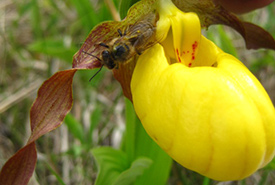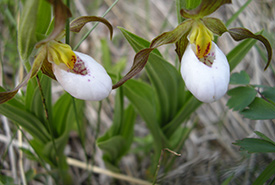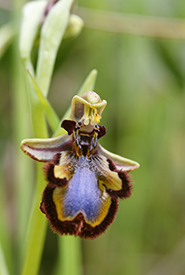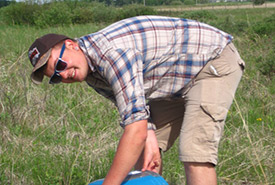Don’t trust lady’s-slippers (if you’re a bee)

This honeybee was tricked into pollinating this yellow lady’s-slipper. (Photo by Steven Anderson/NCC staff)
Before I began working at the Nature Conservancy of Canada (NCC), I spent six years studying the pollination of two species of lady’s-slipper orchids in Manitoba and the northern U.S. While I no longer spend all of my time thinking about these beautiful flowers, I do get to go out a few times a year to monitor their populations on NCC properties in the Tall Grass Prairie Preserve. Let me tell you about why I find them — and their pollination — so cool.
First off, let’s have a quick refresher on pollination. Pollination occurs when pollen is moved from one plant to another and is rubbed off onto a special structure called a stigma. The pollen grain then forms a long tube that stretches from the stigma to an ovule (or egg) within the flower. Finally, the pollen grain releases its sperm cell down this tube, which fertilizes the ovule, allowing the plant to produce seeds.
One downside of being a plant is that you can’t really move around well. So, getting pollen from one flower to another is a challenge. That’s where pollinators come in! Plants and their pollinators usually share an amazing and mutually beneficial relationship. Pollinators move pollen between flowers, which helps the plant reproduce. In exchange, the pollinators get to feed on nectar or pollen.
Now, if I’ve learned anything in biology, it’s that whenever someone says “usually,” they’re going to follow that up with an unusual example. In this case, it’s deceptive flowers!
Related blog posts
Deceptive flowers are flowers that don’t produce nectar or edible pollen for pollinators to consume. An example of this is the lady’s-slipper orchid. Lady’s-slippers do not produce nectar, and their pollen is very sticky, making it impossible for insects to consume. However, deceptive flowers can still be pollinated.

Two small white lady’s-slippers, a threatened species with deceptive flowers (Photo by Steven Anderson/NCC staff)
Like people, most pollinators are not fans of working without food, and most will quickly learn to avoid these deceptive species. Pollinator avoidance is both a blessing and a curse for deceptive flowers; they often suffer from low pollination success. But pollinators will often fly quite a distance before they accidentally visit another deceptive flower. This flight distance ensures that the deceptive flower’s pollen goes to a flower that is unrelated to it, which prevents inbreeding. This mechanism is thought to provide an explanation for why this strange pollination strategy may have evolved.

Some deceptive flowers, such as this mirror orchid, take things one step further and mimic female wasps to attract males for pollination. (Photo by Hans Hillewaert CC BY-SA 4.0)
If deceptive flowers are so unattractive to pollinators, how do they manage to get pollinated? Here a few sneaky strategies that these flowers use:
Mimicry
Deceptive flowers will often look like other species in their habitats to fool pollinators, or they produce large and showy flowers that look like they contain lots of nectar.
Flowering date
Deceptive flowers will often flower early in the year. Early flowering is thought to take advantage of naïve pollinators that haven’t yet learned which flowers are the best food sources. This strategy also reduces competition between deceptive flowers and rewarding flowers.
Flowering length
Flowering for a long period of time increases the chances of a pollinator visiting by mistake.
Lifespan
Many deceptive flowers are long-lived species. So, if they go a season without being pollinated, they can just try again the following year.
The pollination of deceptive flowers is a fascinating topic for both evolution and ecology. Unfortunately, some of these beautiful species, such as small white lady’s-slipper, have lost much of their habitat and are at risk. NCC protects habitat for these species and monitors their populations so that these tricky flowers can continue to fascinate people well into the future.


